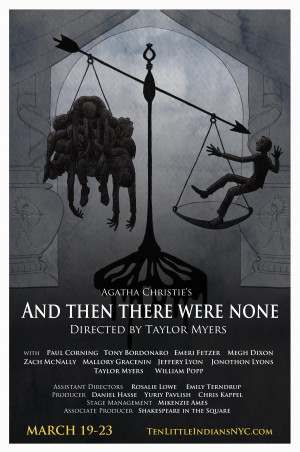You have no items in your cart. Want to get some nice things?
Go shopping
People in New York tend not to notice one another. It’s one of those urban truisms so trite it hardly bears mentioning, until you’re in the middle of a particularly crowded form of public transportation miles from anywhere you’re likely to otherwise go, staring – along with four or five others — over the shoulder of ginger bearded man in a 1940’s flat cap reading a copy of Poe’s stories. In London, doing that might merit the kind of passive-aggressive glare capable of obliterating all life forms in a thirty-mile radius. In New York, that’s just theatre.
Half the wonder of And Then There Were None, a late-night promenade show by Roll the Bones Theatre Company, is getting there. Different tickets offer access to different modes of transportation as audience members are invited to silently encounter and follow one of the ten “little soldiers” of Agatha Christie’s most famous mystery novel from somewhere in New York City ‘s to Soldier Island: the location of which is a closely-guarded secret on the part of the production team, but which is so wildly atmospheric – and unexpected – to be worth the not inconsiderable trek.
Most of the cast are alumni of Sleep No More, a dance-based piece of immersive physical theatre (full disclosure: I’ve seen – and liked – many of the cast of And Then There Were None during my visits to Sleep No More), and this shows. My assigned “soldier”, William Popp – playing the curt police officer Blore – was eminently watchable, capable of sustaining sufficient physical tension to convey enough of a story to make the (silent, public, lengthy) journey to Soldier Island as ominous as the play itself.
Once at our Soldier Island manor house, however, the tension drops somewhat. The first act of the play – in which we discover why these ten seemingly unconnected strangers have been invited to this enigmatic island, and the crimes of which they have been accused – is hampered both by the demands of Christie’s novel (attempting to introduce ten characters and their backstories in as many minutes give the opening moments the feel of a particularly macabre name game) and by the problematic acoustics of that section of the space; several of the actors’ lines spoken in the “parlour” section of the set are inaudible. So too does the transition from the “transport” section of the play to what at first glance seems like a more traditionally staged fourth-wall-maintaining piece come as a bit of a disappointment after such a lengthy period of tension-building.
Once the action begins to move, however, and the characters whittled down by nefarious means to a more manageable number (although Tony Bordonaro, as a charismatic, car chase-loving early victim of our unknown host’s designs, makes the most of a relatively brief appearance), the show picks back up relatively swiftly. Alliances are forged, and broken; clues are discovered and discarded; rooms that seemed safe a moment earlier are littered with corpses, and, once the lights go out, it becomes all too likely that the show’s title may well indicate its conclusion.
The performances are generally very good – standouts include Megh Dixon as the prudish spinster Emily Brent and Mallory Gracenin, who comes to dominate the show’s emotional narrative as Vera Elizabeth Claythorne, on whom the island’s toll is as psychological as it is physical – although the age- and accent-blind casting (Christie’s dialogue is so often written so specifically to a certain kind of posh, blustering middle-aged Englishman that it can seem jarring out of the mouths of twenty- and thirty-something Americans) takes a degree of getting used to.
That said, however, the skilful direction – the show’s final moments and its handling of the whodunnit elements of the novel’s plot – are particularly inspired, and the cast’s uniform skill at conveying story physically as well as verbally do much to keep the pace quick as the pulses slow.
Taylor Myers and his team have done an inspired job of making And Then There Were None one of the most creative, atmospheric fringe shows I’ve seen thus far in 2014.

About Tara Isabella Burton
Tara Isabella Burton's work has appeared or is forthcoming in Arc, The Dr TJ Eckleburg Review, Guernica, and more. In 2012 she received the Shiva Naipaul Memorial Prize for travel writing. She is represented by the Philip G. Spitzer Literary Agency of New York; her first novel is currently on submission.




